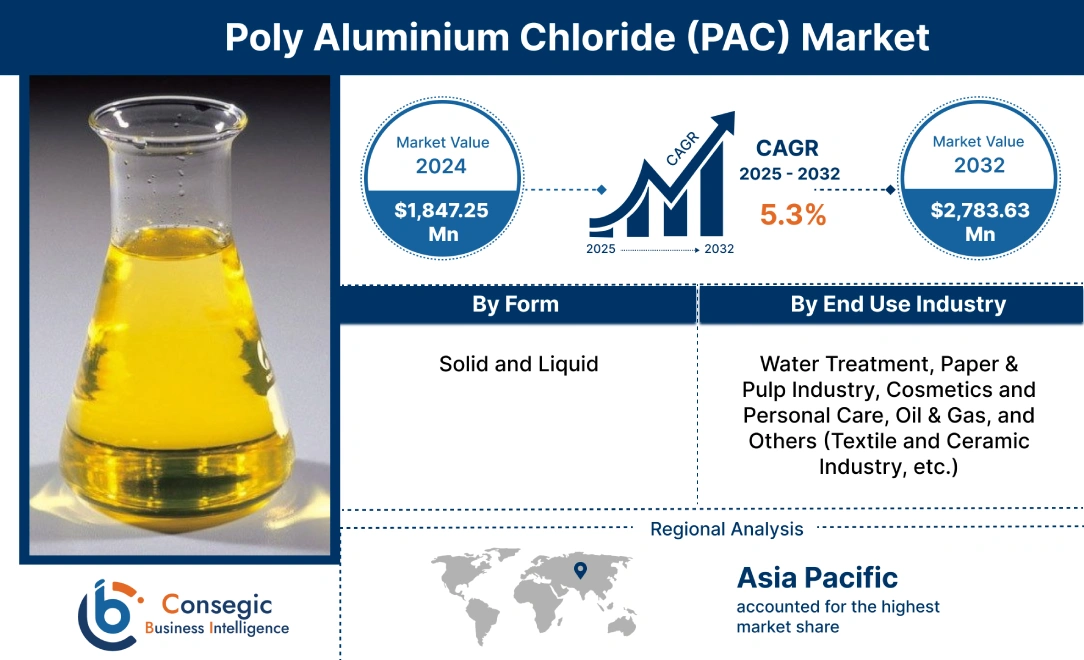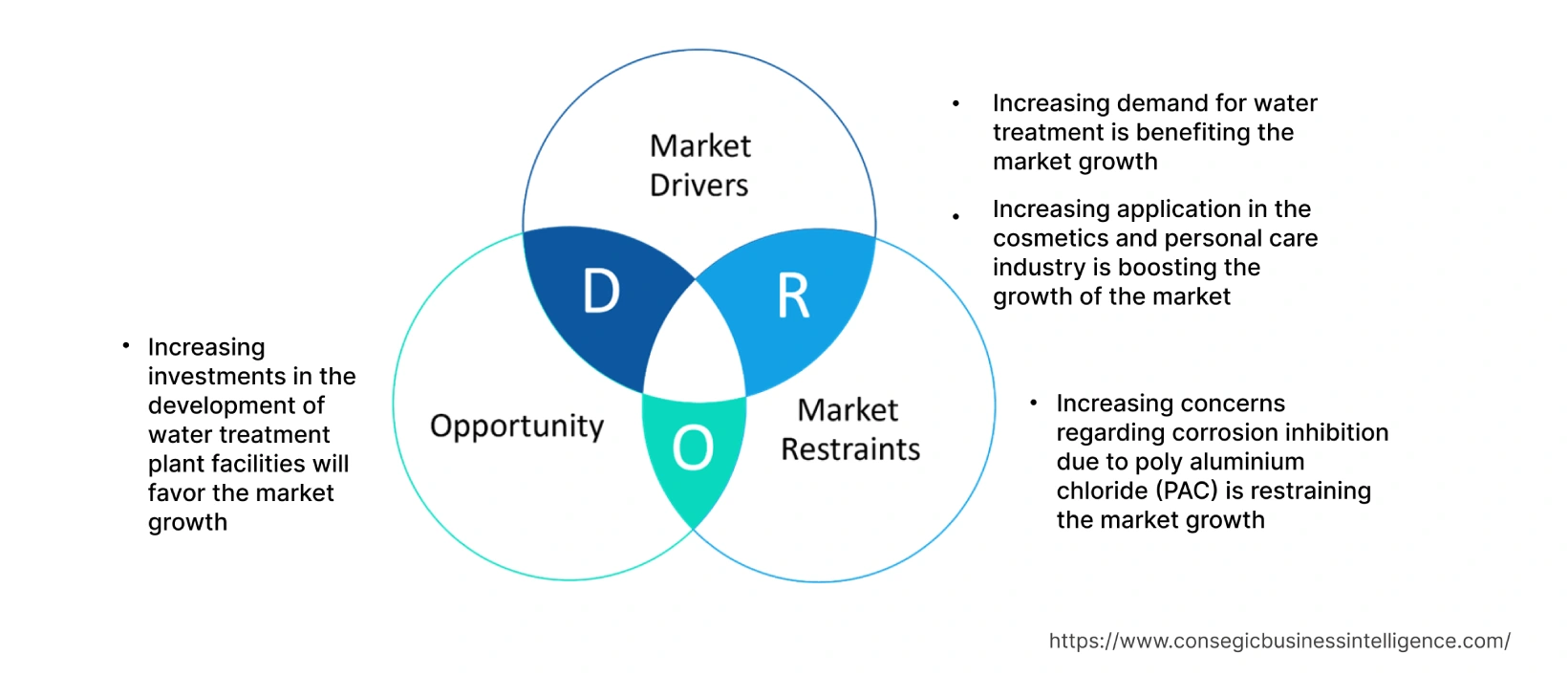- Summary
- Table Of Content
- Methodology
Poly Aluminium Chloride (PAC) Market Size :
Consegic Business Intelligence analyzes that the Poly Aluminium Chloride (PAC)Market size is estimated to reach over USD 2,783.63 Million by 2032 from a value of USD 1,847.25 Million in 2024 and is projected to grow by USD 1,911.50 Million in 2025, growing at a CAGR of 5.30% from 2025 to 2032.
Poly Aluminium Chloride (PAC) Market Scope & Overview:
Poly aluminium chloride is an acid compound made of aluminium, chloride, hydrogen, and oxygen. The color of the solution is slightly yellow and can be referred to by other names such as PAC, polyaluminium chloride sulfate solution, or PAX. Polyalminum chloride is used as a flocculant to remove suspended particles and impurities in water.
Poly aluminium chloride is available in two basic forms such as solid and liquid. It is utilized across various end-user industries including water treatment, paper industry, cosmetics and personal care, oil and gas, textile and ceramic industry, and others. In the paper In the water treatment, paper, and pulp industry, poly aluminium chloride is used as a coagulant for the removal of impurities from the water. Poly aluminium chloride provides various advantages such as ease of application, rapid flock formation, less reduction of pH, lower residual, and others. Due to this, the compound is getting popular across various end-user industries, leading to increasing demand for the chemical.
Poly Aluminium Chloride (PAC) Market Insights :
Key Drivers :
Increasing demand for water treatment is benefiting the market growth
Poly aluminium chloride (PAC) is primarily used in the treatment of drinking water and wastewater treatment to remove contaminants such as organic matter, suspended solids, and colloidal particles. Water treatment is an important aspect across both municipal as well as industrial applications. The growing scarcity of drinking water due to the increasing population across the globe and the lower availability of fresh drinking water, are the major factors influencing the demand for poly aluminium chloride across municipal water storage and supply facilities. The compound is also used across industrial applications for wastewater treatment in wastewater treatment facilities. Stringent government regulations for wastewater treatment are the major factors driving the demand for poly aluminium chloride (PAC) for water treatment applications, which is further expected to drive market growth. For instance, in January 2023, the U.S. Environmental Protection Agency (EPA) announced the Effluent Guidelines Program Plan 15, which regulated the amount of effluent discharge from industrial sources. These guidelines regulate industries across the country to remove all the impurities from their effluent water before releasing it into the environment. Therefore, the increasing regulations and standards for wastewater treatment along with the high demand for fresh drinking water. This, in turn, is benefiting the market growth.
Increasing application in the cosmetics and personal care industry is boosting the growth of the market
Poly aluminium chloride (PAC) is used in the cosmetics and personal care industry as an active ingredient for the manufacturing of deodorants and antiperspirants. An active ingredient present in deodorants and antiperspirants helps to reduce overall sweating and block the sweat ducts. The formulation of Poly aluminium chloride (PAC) in deodorants and antiperspirants is available in the form of sprays, roll-ons, creams, powders, etc. Antiperspirants block the pores on the outer layer of the skin, by reducing the amount of sweat allowed to the surface. The growing consumer awareness regarding personal grooming and maintaining personal hygiene is increasing the demand for these deodorants and antiperspirants. Due to this various companies are focusing on the launch of new and advanced products to cater to the heavy consumer demand.
For instance, in April 2023, Dove, which is the personal care brand of Unilever, Plc. a multinational conglomerate company, announced the launch of deodorant ranges. Hence, the growing personal care industry along with the increasing demand and innovations in deodorants and antiperspirants is accelerating the demand for poly aluminium chloride (PAC) as the compound is in the cosmetics and personal care industry. This, in turn, is driving the growth of the market.
Key Restraints :
Increasing concerns regarding corrosion inhibition due to poly aluminium chloride (PAC) is restraining the market growth
Poly aluminium chloride (PAC) has various advantages across water treatment, personal care, cosmetics, textile, paper, and pulp industries. It is primarily used as a coagulant for the removal of suspended particles from effluent water in different industries. Poly aluminum chloride (PAC) is a widely used water treatment chemicals, but it has been shown to cause corrosion in some cases. This is because PAC can react with dissolved metals in water to form insoluble hydroxides, which can then flake off and cause damage to metal surfaces. A high concentration of poly aluminium chloride is used for water treatment applications across these industries. Liquid poly aluminium chloride is acidic, due to which, this liquid poly aluminium chloride is mixed with water forms precipitate aluminium hydroxide (Al(OH)3), which is corrosive. The corrosive nature of the precipitate, a high risk of corrosion of equipment arises in the industries. Poly aluminium chloride (PAC) leads to the corrosion of stainless steel or metal pipes, and precipitation tanks. Thus, the high risk of corrosion of the pipe and utensils due to the poly aluminium chloride (PAC) is posing a major roadblock to the revenue growth of the market.
Future Opportunities :
Increasing investments in the development of water treatment plant facilities will favor the market growth
Poly Aluminium Chloride (PAC) is ideally used for water treatment in both industrial as well as municipal applications. The growing industrialization across the globe is leading to a high amount of wastewater generation. This wastewater needs to be treated before releasing into the environment. Stringent government regulations and environmental policies are leading the companies to focus on the launch of water treatment plants. For instance, in July 2021, The Lenzing Group, a provider of specialty fibers announced an investment of USD 25.57 million for the construction of a wastewater treatment plant at its Grimsby, U.K. plant. Furthermore, in May 2022, the Government of Qatar announced a public-private partnership with Al Attiya Motors & Trading Company and Gulf Investment Corporation (GIC) for the construction of a sewage treatment plant across Qatar.
Hence, the expansion strategies for wastewater treatment at the global level are spurring the demand for poly aluminium chloride (PAC) for various applications. This prominent factor is supplementing the poly aluminium chloride (PAC) market.
Poly Aluminium Chloride (PAC) Market Report Insights :
| Report Attributes | Report Details |
| Study Timeline | 2019-2032 |
| Market Size in 2032 | USD 2,783.63 Million |
| CAGR (2025-2032) | 5.3% |
| By Form | Solid and Liquid |
| By End-user Industry | Water Treatment, Paper & Pulp Industry, Cosmetics and Personal Care, Oil & Gas, and Others (Textile and Ceramic Industry, etc.) |
| By Region | North America, Europe, Asia-Pacific, Latin America, and Middle East & Africa |
| Key Players | Airedale Group, Feralco AB, GEO Specialty Chemicals, Neelchem, Grasim Industries Ltd., Kemira Oyj, Synergy Multichem Pvt. Ltd., USALCO, and Gujrat Alkalies and Chemical Limited |
Poly Aluminium Chloride (PAC) Market Segmental Analysis :
By Form :
The form segment is categorized into solid and liquid. In 2024, the polyurethane dispersions (PUDs) segment accounted for the highest market share in the overall poly aluminum chloride (PAC) market and holds the highest CAGR over the estimated period. The liquid form of poly aluminium chloride is a solution of PAC dissolved in water which is utilized for various applications such as water treatment, industrial wastewater treatment, effluent treatment, pool water treatment, and others. In the paper and pulp industry, the liquid form of poly aluminum chloride is used as a retention and drainage aid, which improves the efficiency of the paper-making process by enhancing fiber retention and reducing particle loss in the paper and pulp industry. The increasing demand for paper for various applications globally is driving the segment growth over the estimated period. For instance, according to the data published by the European Association representing the paper industry in February 2023, the demand for paper increased by 3.6% in 2021. Thus, due to the above beneficial properties, the deployment of Poly Aluminium Chloride (PAC) is increasing for various end-use applications, which, in turn, is benefiting the market growth.
By End-Use-Industry :
The end-user industry segment is categorized into water treatment, paper industry, cosmetics and personal care, oil & gas, and others (textile and ceramic industry, etc.). In 2024, the water treatment segment accounted for the highest market share of 31.50% in the poly aluminium chloride (PAC) market. Poly Aluminium Chloride (PAC) is employed in the water treatment industry across various sectors. including industry, roofing, and others to provide superior mechanical protection. Furthermore, poly aluminium chloride (PAC) is deployed as an important chemical for wastewater treatment. Poly aluminium chloride forms coagulants and flocculants in the wastewater and settles down at the bottom by separating the clean water. The growing industrialization worldwide is contaminating water resources. Various countries worldwide are focusing on municipal wastewater treatment and reusing activities. This, in turn, will boost the segment growth in the upcoming years.
However, the paper & pulp industry segment is expected to be the fastest-growing segment during the forecast period because of the high demand for neutral paper sizing, retention aid, filter aid, and others.
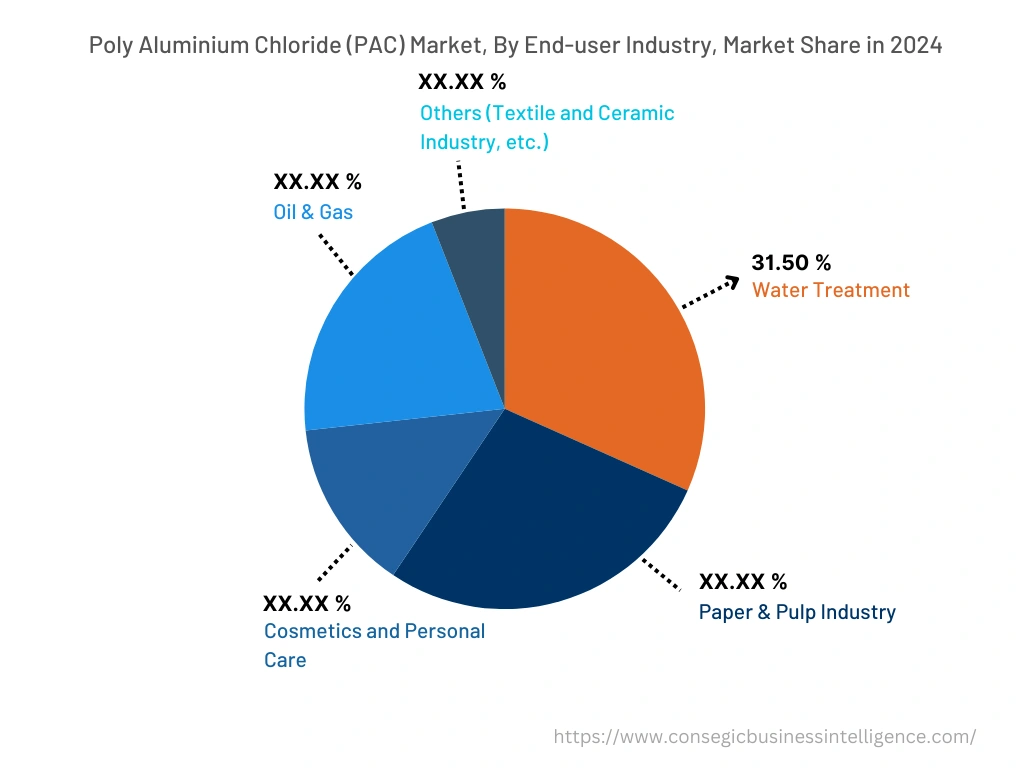
By Region :
The regional segment includes North America, Europe, Asia Pacific, Middle East and Africa, and Latin America.
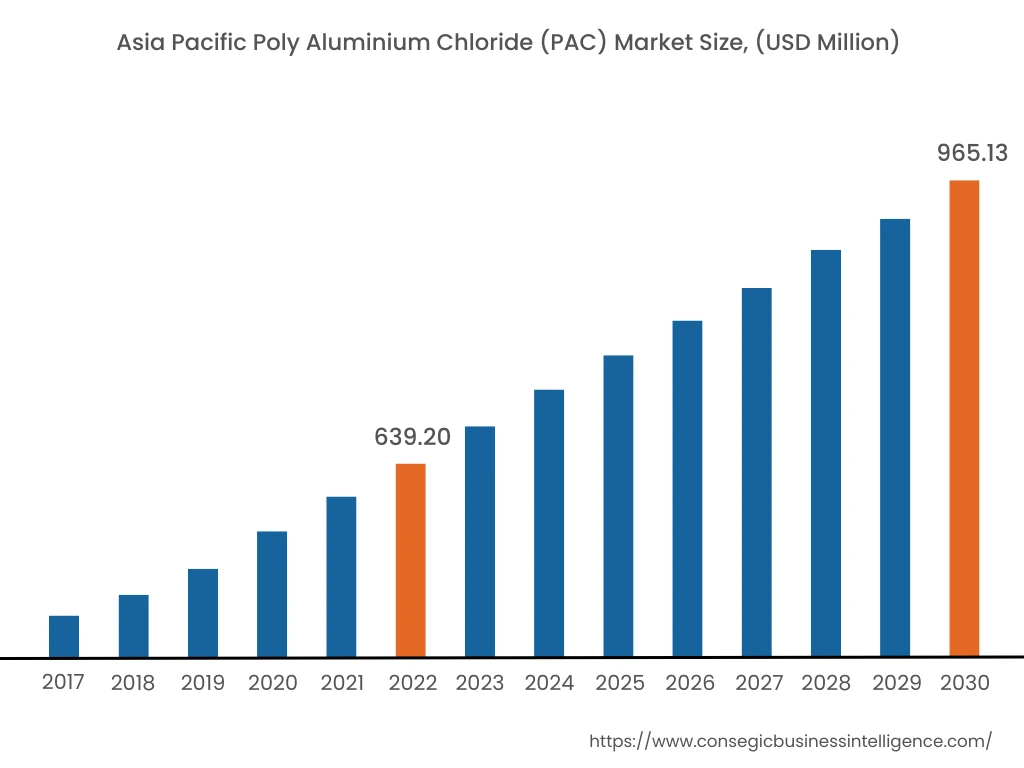
In 2024, Asia Pacific accounted for the highest market share of 35.75% and was valued at USD 544.03 million, and is expected to reach USD 847.61 million in 2032. In Asia Pacific, China accounted for the highest market share of 26.05% during the base year 2024 owing to the rising demand for clean water in residential, industrial, and municipal sectors. Countries such as China, India, and Japan are investing heavily in water treatment infrastructure to address issues of water scarcity and pollution. PAC, widely used as a coagulant in water and wastewater treatment, benefits from its superior performance compared to traditional coagulants like alum. The growth of industries such as paper manufacturing, food and beverage, and textiles in the region is further driving the demand for PAC, as these industries require effective water treatment solutions for their processes. Additionally, increasing urbanization and government initiatives supporting water management projects are further bolstering market expansion.
Moreover, North America is expected to grow at the fastest CAGR of 14.8% during the forecast period due to the rising demand for clean water in residential, industrial, and municipal sectors. Countries such as China, India, and Japan are investing heavily in water treatment infrastructure to address issues of water scarcity and pollution. PAC, widely used as a coagulant in water and wastewater treatment, benefits from its superior performance compared to traditional coagulants like alum. The growth of industries such as paper manufacturing, food and beverage, and textiles in the region is further driving the demand for PAC, as these industries require effective water treatment solutions for their processes. Additionally, increasing urbanization and government initiatives supporting water management projects are further bolstering market expansion.
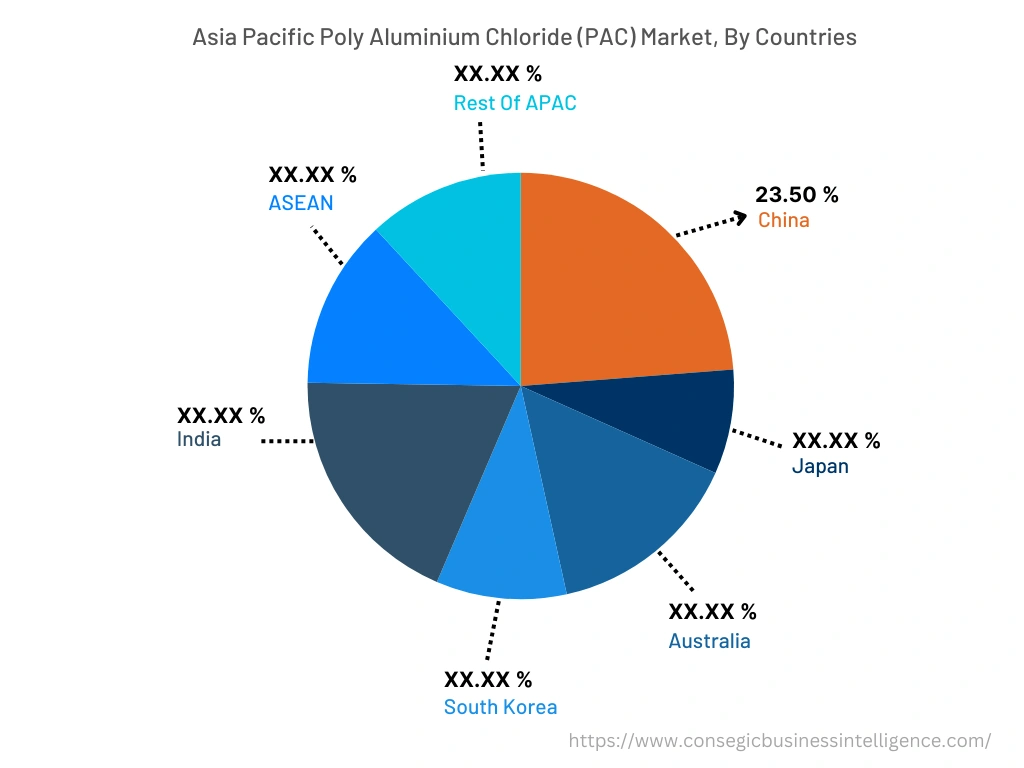
Top Key Players & Market Share Insights:
The Poly Aluminium Chloride (PAC) Market is highly competitive, with several large players and numerous small and medium-sized enterprises. These companies have strong research and development capabilities and a strong presence in the market through their extensive product portfolios and distribution networks. The market is characterized by intense competition, with companies focusing on expanding their product offerings and increasing their market share through mergers, acquisitions, and partnerships. The key players in the market include-
- T&CO.
- Harry Winston, Inc.
- HStern
- GRAFF
- RENAISSANCE GLOBAL LIMITED
- De Beers Forevermark
- Pandora
- CARTIER
- Le Petit-fils de L.U. Chopard & Cie S.A.
- Swarovski
- Pomellato S.p.A.
Recent Industry Developments :
- In August 2022, Pandora launched their new collection with lab-created diamonds and 100% recycled silver and gold.
- In December 2021, Harry Winston, Inc. announced the opening of their new retail salon in Milan, Italy.
Key Questions Answered in the Report
What was the market size of the Poly Aluminium Chloride (PAC) industry in 2024? +
In 2024, the market size of poly aluminium chloride (PAC) was USD 1,847.25 million.
What will be the potential market valuation for the poly aluminium chloride (PAC) industry by 2030? +
In 2030, the market size of poly aluminium chloride (PAC) will be expected to reach USD 2,441.68 million.
What are the key factors driving the growth of the poly aluminium chloride (PAC) market? +
Increasing demand for water treatment is benefiting the market growth.
What is the dominating segment in the poly aluminium chloride (PAC) market by end-user industry? +
In 2024, the water treatment segment accounted for the highest market share of 31.50% in the overall poly aluminium chloride (PAC) market.
Based on current market trends and future predictions, which geographical region is the dominating region in the poly aluminum chloride (PAC) market? +
Asia Pacific accounted for the highest market share in the overall poly aluminium chloride (PAC) market.
